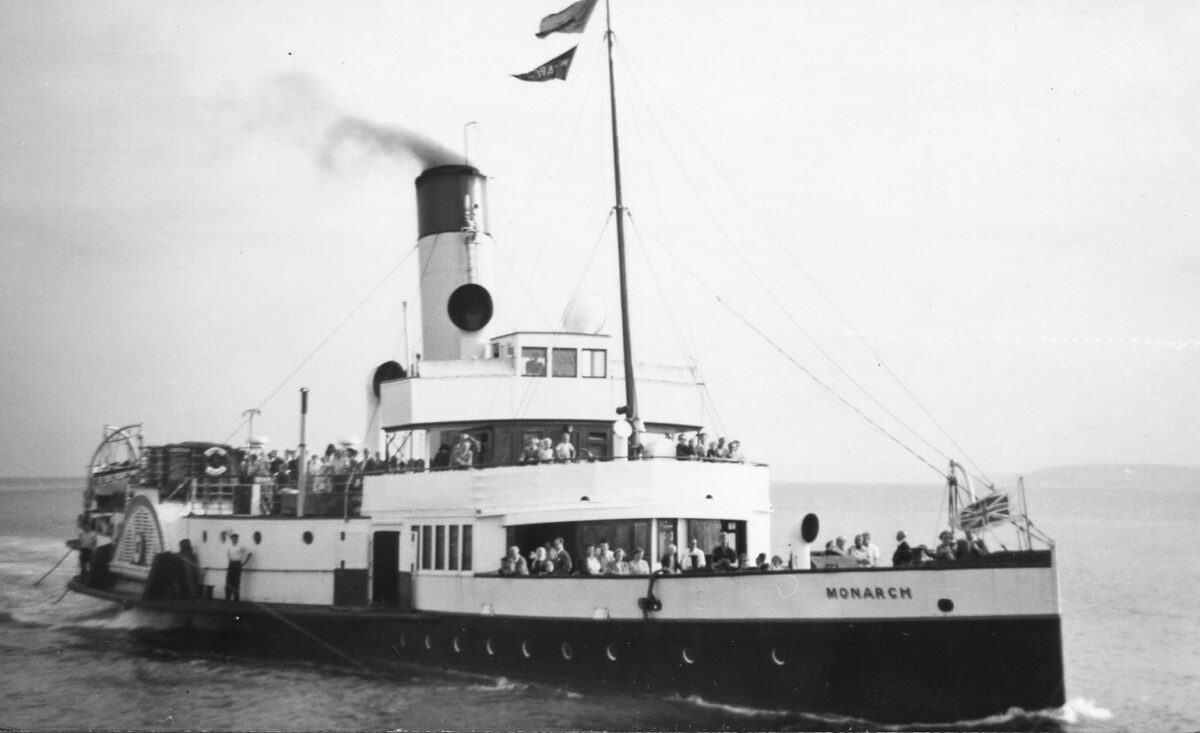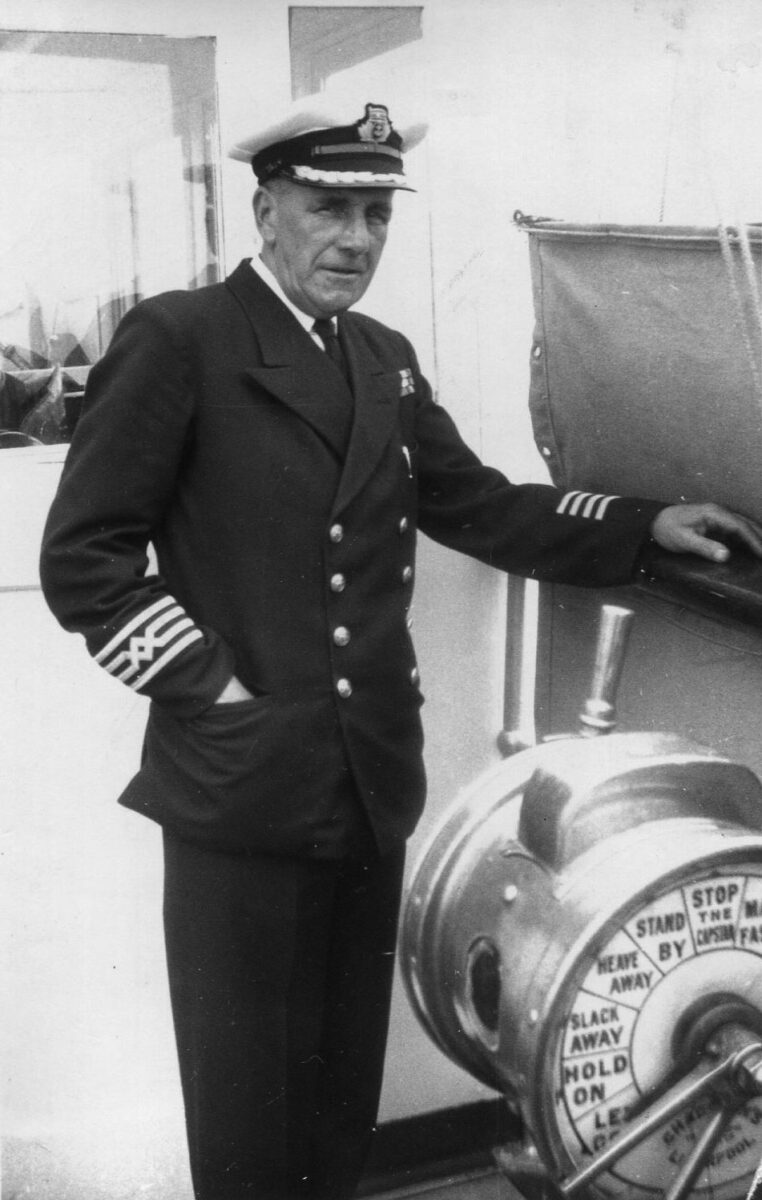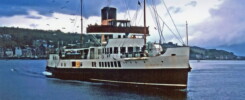
On Wednesday 10th August 1960 Monarch was rostered to spend the day on the Bournemouth/Swanage service followed by a non-landing evening cruise to Totland Bay, Isle of Wight.
She was due away from Poole (9am) for Bournemouth (10am) for the 45 minute run across to Swanage with departures from Bournemouth for Swanage at 10.30am, 12.15pm, 2.30pm and 4.15pm returning from Swanage at 11.30am, 1.15pm, 3.15pm and 5pm.

On her return to Bournemouth after all that she was then rostered to set off at 6pm for a non-landing cruise to Totland Bay, Isle of Wight which was about one and a half hours each way, leaving Totland ( 7.30pm) for Bournemouth (9pm) and Poole (10pm). The fare for this was 7/- (£8.20 today).
This evening cruise, which was only rostered on busy days during the peak weeks, had a triple role. Firstly it was designed to collect any overflow of passengers from the Isle of Wight which Embassy had been unable to bring back on her 4.45pm departure from Totland Bay. Secondly it offered a pleasant evening cruise for passengers from Bournemouth. And thirdly it offered a later departure time from Totland Bay for any who wished to spend longer ashore on the Island.

Monarch’s onboard catering on the Swanage service was modest to say the least usually offering only hot and colds drinks and light refreshments. However to encourage passengers aboard, and perhaps to pacify those who had wanted to catch the Embassy at 4.45pm and found that they had to wait a further two and three quarter hours to be picked up by Monarch (by which time they might have missed their evening meal in their hotels), “Special Ham and Egg Suppers” were advertised and priced at 4/6 (£5.22 today).
For this the ingredients of ham, boxes of eggs, and a sack of potatoes don’t require much storage space and all are quick and easy to prepare and cook according to demand. To fry an egg takes only a few minutes. The ham can be served to accompany it cold. And you can get a lot of chips on the go at any one time in a couple of large 18″ frying pans or not if there aren’t many takers.
All these ingredients have quite long shelf lives so if they weren’t used today they were equally good tomorrow or the next day or the day after that and so on. Indeed the ham and eggs would generally have been good for a week or more and the potatoes for much longer so waste would have been kept to a minimum. This would have put a smile on the face of Cosens’ management ever seeking to maximise profitability and minimise loss.
The first departure from Bournemouth to Swanage in the morning was also billed as a combined steamer and motor coach tour of the “Beauty Spots of Dorset with a steamer trip in the sheltered waters to Swanage, then a 60 mile tour of beautiful Dorset by motor coach with stop at Weymouth for one and a quarter hours and Lulworth Cove for half an hour”.
As with the combined steamer and motor coach tour of the Isle of Wight this was a popular option for which a high fare of 16/6 (£19 today) could be charged for what was only an hour and a half steaming on Monarch. For this Cosens received a healthy commission from the coach operator which was in effect free money.
The sharp eyed amongst you will already have picked up that this tour was billed on the steamer notice to leave at 10.45am and that the Swanage service departure was for 10.30am. As this was the same ship for both, Monarch, some fudging of her departure time must therefore have been arranged so as not to leave people behind and cover this error in the steamer notice copy.

Tiny Point of Detail 1: I remember Captain Defrates telling me that on the way back up Poole Harbour at the end of each day after passing Brownsea Island the stokers started to work back the coal fires in the six furnaces of Monarch’s double ended Scotch boiler prior to arrival. So, by the Stakes Buoy, although the telegraph was still on “Full Ahead” Monarch’s speed was not quite that as she flapped her way up to berth at Poole Quay.
Tiny Point of Detail 2: Captain Defrates didn’t much like sleeping aboard Monarch in the captain’s cabin, which was situated on the starboard side under the bridge. He would be kept awake by hearing all the noise and goings on on the quay so sometimes he booked a room in one of Poole’s many local pubs in which he knocked back a couple of rum and blackcurrants before turning in.
Tiny Point of Detail 3: I am grateful to Brian Jackson, who worked aboard Monarch as second engineer, for pointing out that shehad previously coaled up from wagons left on the harbour tramway at Poole Quay. Men from the coal merchant brought it aboard in large wicker baskets as it was loose in the coal wagons as large lumps of Welsh steam coal. The tramway closed in early 1960 so for Monarch’s last summer in service the coal was brought down in lorries and carried aboard in the normal way a coalman delivered it to a house and dropped it down the bunker hatches in each alleyway alongside the boiler room and, of course being bagged, the lumps were smaller. When this was taking place canvas curtains were put across the alleyways between the boiler room and engine room to try to keep the coal dust away from the sparkling machinery. Monarch was designed with self-trimming coal bunkers with a capacity of 40tons, 20 tons each side, which was intended to provide enough coal for about a week in service burning just under 6 tons a day based roughly on 10 hours steaming. Loading even 6 tons by hand in this way every day is quite a job and it was often gone midnight before the bunkers were full and silence reigned once again aboard Monarch.
Kingswear Castle returned to service in 2023 after the first part of a major rebuild which is designed to set her up for the next 25 years running on the River Dart. The Paddle Steamer Kingswear Castle Trust is now fund raising for the second phase of the rebuild. You can read more about the rebuilds and how you can help if you can here.
John Megoran
This article was first published on 10th August 2021.


